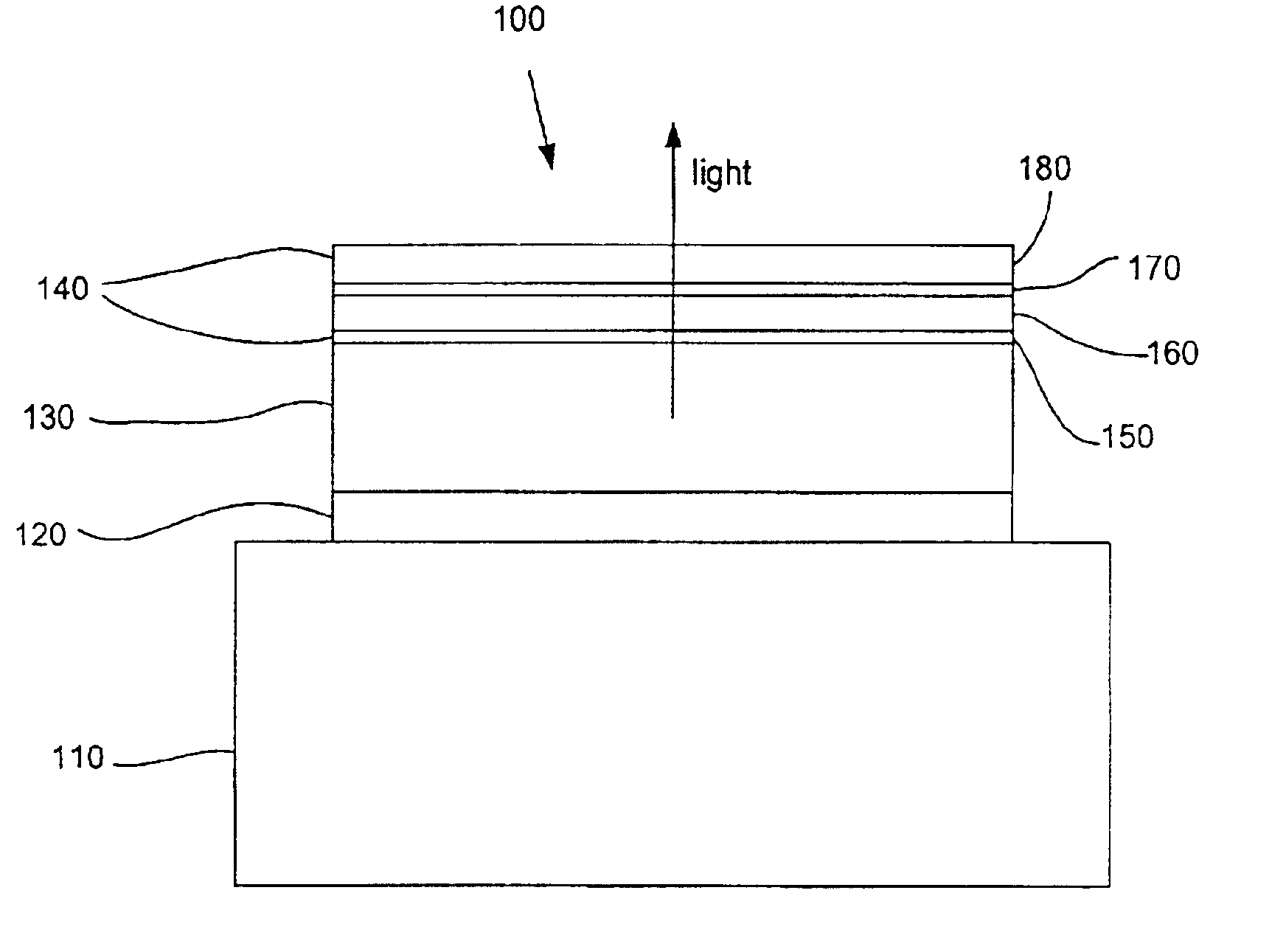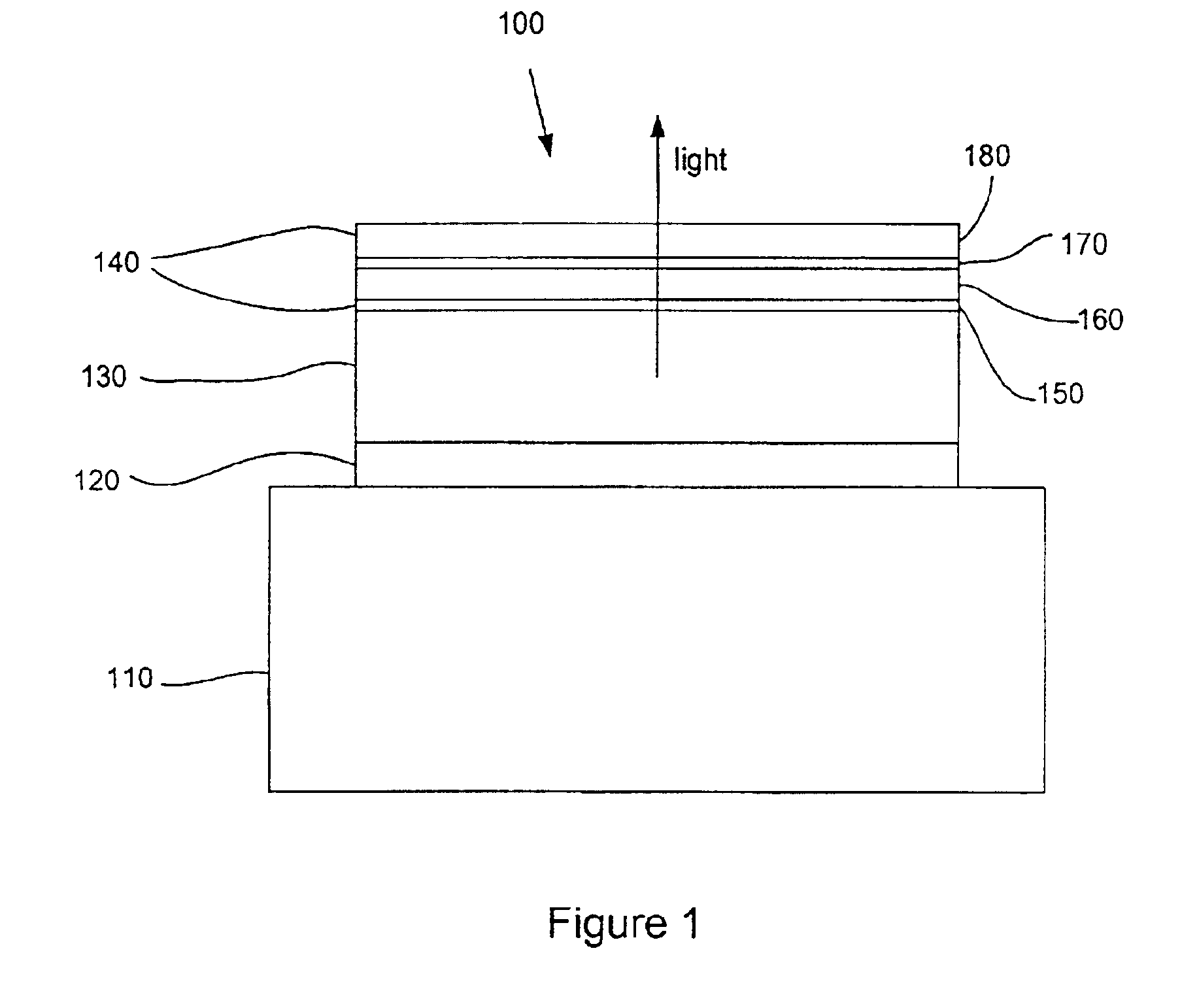Transparent electrodes
a transparent electrode and electrode technology, applied in the field of organic semiconductor devices, can solve the problems of difficult to tune inorganic emissive materials, damage to organic layers, and difficult to detect inorganic emissive materials, so as to reduce the electrical field
- Summary
- Abstract
- Description
- Claims
- Application Information
AI Technical Summary
Benefits of technology
Problems solved by technology
Method used
Image
Examples
example 1
[0071]For comparative purposes, an array of OLEDs similar to the prior art was fabricated by depositing the following layers, in sequence, through appropriate masks. The deposition of all material was by thermal evaporation, except for ITO (which was only deposited in examples 2, 3 and 4), which was deposited by sputtering. Due to the use of different feedback mechanisms to monitor the deposition sources, the source parameter that was controlled may be either a temperature or a voltage. The MgAg layer was co-deposited from separate Mg and Ag targets to the total thickness shown (1000 Å in example 1).
[0072]
MaterialDep. Rate (Å / s)ThicknessSource Temperature (C.) or PowerCuPc1.2100345.1C.NPD3500254.4C.Alq3500266.7C.LiF1-21441.2VAl21088.9VCuPc2400387.4C.MgAg 3 (Mg)100040.5V1.2 (Ag)—43.5V
[0073]Although an Ag deposition rate of 1.2 was read on the dial, it is expected that the deposition rate was actually about 0.3 due to a tooling factor in this and in the other examples.
example 2
[0074]An array of OLEDs similar to the device shown in FIG. 1 was fabricated by depositing the following layers, in sequence. The equipment and masks used were the same as for example 1:
[0075]
MaterialDep. Rate (Å / s)ThicknessSource Temperature (C.) / PowerCuPc1.2100345.1C.NPD3500257-258C.Alq3500304-331C.LiF1-21440.9-41.4VAl21088.9VCuPc2400347-396C.MgAg 3 (Mg)10041.5V1.2 (Ag)—43.5V
[0076]A layer of ITO was then deposited by sputtering. The chamber contained 3 mTorr of an Ar / O2 mixture, and the power applied to the chamber was about 250 W. The power applied to the target was about 1.25-1.26 A at 1.98.6-197 V. The substrate was passed over the target 3 times at a speed of 17 inches per minute. With these parameters, it is expected that the thickness of ITO deposited was about 500 Å.
example 3
[0077]An array of OLEDs similar to the device shown in FIG. 3 was fabricated by depositing the following layers, in sequence. The equipment and masks used were the same as for example 1:
[0078]
MaterialDep. Rate (Å / s)ThicknessSource Temperature (C.) / PowerCuPc1.2100345.1C.NPD3500249C.Alq3500263C.LiF1-21440.0-40.7VAl21088.9VCuPc2400348C.
[0079]A layer of ITO about 500 Å thick was deposited by sputtering using parameters similar to those given for example 2, and the power applied to the target was 1.26 A at 198.3-197.5 V.
PUM
 Login to View More
Login to View More Abstract
Description
Claims
Application Information
 Login to View More
Login to View More - R&D
- Intellectual Property
- Life Sciences
- Materials
- Tech Scout
- Unparalleled Data Quality
- Higher Quality Content
- 60% Fewer Hallucinations
Browse by: Latest US Patents, China's latest patents, Technical Efficacy Thesaurus, Application Domain, Technology Topic, Popular Technical Reports.
© 2025 PatSnap. All rights reserved.Legal|Privacy policy|Modern Slavery Act Transparency Statement|Sitemap|About US| Contact US: help@patsnap.com



